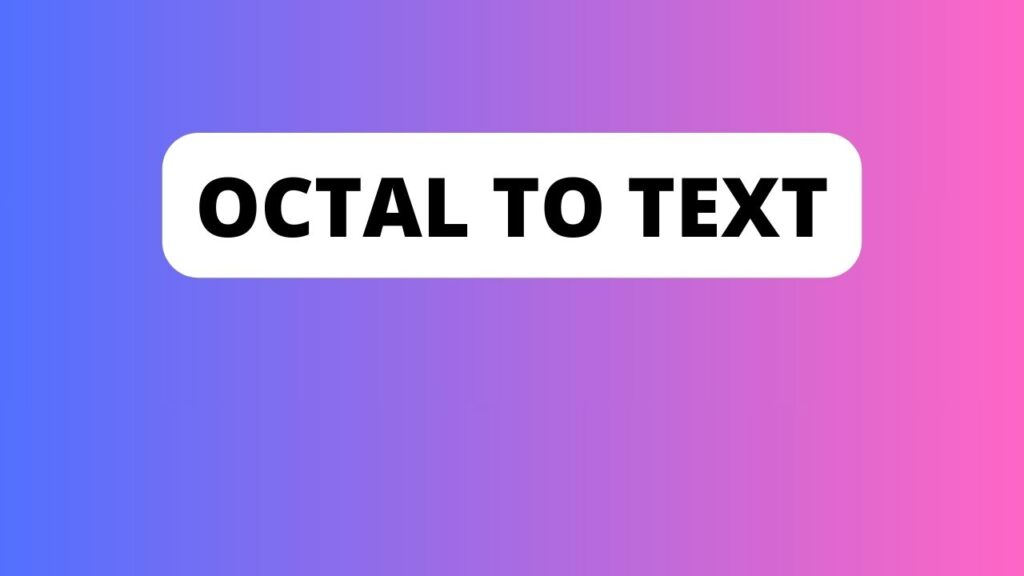Introduction
Octal to text conversion is a fundamental process in computing, aiding in the translation of octal values into human-readable text. Understanding this process is crucial for programmers, data analysts, and anyone working with computer systems. This guide will delve into the intricacies of converting octal values to text, providing detailed insights and practical examples.
Understanding Octal Conversion
Exploring the Octal Number System
Octal, a base-8 numeral system, utilizes digits from 0 to 7. It stands as a fundamental part of computing, particularly in low-level programming and file permission settings. The system’s simplicity lies in its concise representation of binary data.
Octal to text conversion involves translating octal values into their corresponding ASCII characters. Each octal digit represents a sequence of three bits, forming a character code in the ASCII table.
Methods of Octal to Text Conversion
Direct Conversion Method
Direct conversion entails matching octal values with their corresponding ASCII characters based on their decimal equivalents. This method involves a step-by-step mapping process, providing a clear pathway to deciphering octal values into text.
Python Script for Octal to Text Conversion
Leveraging programming languages like Python streamlines the conversion process. By utilizing built-in functions or custom scripts, programmers can swiftly convert octal values to text, enhancing efficiency in data manipulation tasks.
Utilizing Octal to Text Conversion in Programming
File Permissions and Octal Values
In Unix-based systems, file permissions are represented using octal notation. Understanding octal values is crucial for configuring file permissions effectively. By translating these values into human-readable text, users can comprehend and modify file access permissions effortlessly.
Encoding and Decoding Operations
Octal to text conversion plays a pivotal role in encoding and decoding sensitive information. Encryption algorithms often employ octal representation as an intermediate step in converting data to and from a readable format.
The octal numeral system is the base-8 number system, and uses the digits 0 to 7. That means there are only 8 symbols or digits (0, 1, 2, 3, 4, 5, 6, 7) used to form other numbers. The main advantage of using the octal number system is that it uses fewer digits than the decimal and hexadecimal number system.
Why 8 in octal is 10?
The octal, or oct for short, is the base-8 positional numeral system, and uses the digits 0 to 7. This is to say that 10octal represents eight and 100octal represents sixty-four. However, English, like most languages, uses a base-10 number system, hence a true octal system might use different vocabulary. in decimal.

FAQs
What is the significance of octal to text conversion in cybersecurity? Octal to text conversion aids in deciphering encrypted data, contributing to cybersecurity by facilitating the interpretation of encoded messages.
How can one perform octal to text conversion manually? Manual conversion involves understanding the ASCII table and sequentially matching octal values with their corresponding characters.
Is octal to text conversion applicable only in programming? While widely used in programming, octal to text conversion extends its utility to various fields requiring data interpretation, including cryptography and cybersecurity.
Why is octal conversion essential in file permissions? Octal representation simplifies the visualization and modification of file permissions, enabling users to control access levels effectively.
Can octal to text conversion be automated in programming languages? Yes, many programming languages offer built-in functions or libraries that automate octal to text conversion, streamlining the process for developers.
Are there any risks associated with incorrect octal interpretation? Misinterpreting octal values can lead to errors in file permissions, potentially compromising system security or functionality.
Conclusion
Mastering octal to text conversion is pivotal for individuals navigating programming, cybersecurity, and data interpretation realms. This guide has provided a comprehensive overview, equipping readers with the knowledge to effortlessly translate octal values into meaningful text.
